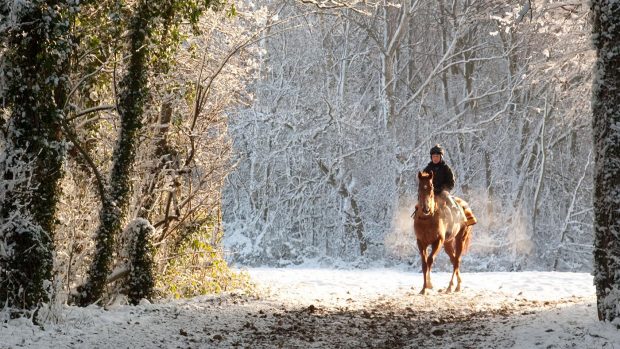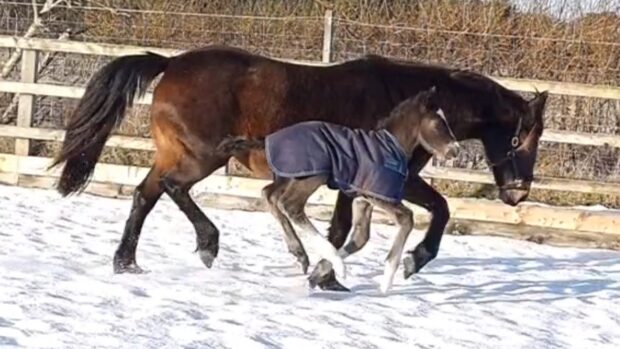The winter months are always a challenge for horse owners, so we asked top riders, trainers and amateurs for their tips to make the cold and wet winter days more bearable. Here is what they had to say...
Exercising your horse
1. “Don’t be a martyr when it comes to working your horse. If it’s miserable for you, it’s going to be miserable for him as well.” Karen Bush, instructor and author
2. “A 20min lungeing session will allow your horse to stretch his legs and can help to keep your horse fit if you don’t have the time to school him.” Claire Lilley, trainer and author
3. “A horse walker really helps to ease exercise issues when you have limited hours of daylight.” Bryony Wilson, eventer
4. “Variety is important to keep your sport horses fit and entertained. Take every opportunity to hack and bring as much variety as possible into your training in the school. With the young horses, I’ll do gridwork or loose jumping.” Laura Tomlinson, British Olympic dressage rider
5. “When exercising, we do a lot of riding and leading. We can get just as many horses exercised that way during less hours of daylight.” Tricia Hirst, endurance rider
6. “Try to exercise your horses most days to get their circulation going, but if you don’t manage to get out due to bad weather, make sure you adjust your feed rations accordingly.” Sandra Low-Mitchell, showjumper
7. “Incorporate a ground schooling session at least once a week to add variety and help maintain topline. Learning to long-rein effectively will benefit not only the horse but rider fitness too.” Dr Kathryn Nankervis, Hartpury College equine therapy lecturer
8. “When riding in the rain use a waterproof wrap-around exercise sheet to keep you and your horse dry. Avoid riding on the outside track in the outdoor manège, so it doesn’t get too boggy.” Vikki Weaver, dressage rider
Healthy happy horses
9. “Feed good-quality oil to your horses through the winter months. It’s brilliant for keeping condition on and for the coat.” Julian Marczak, chairman of the Association of British Riding Schools
10. “Cut down stable dust by using good quality hay and dust-free bedding. Ensure the stables are well ventilated and horses are turned out to minimise stable coughs and colic.” Karen Coumbe, H&H veterinary advisor
11. “When your horses are hot and sweaty, a solarium is wonderful. They’re very expensive, but worth their weight in gold. Alternatively, red heat lamps can do the job.” Lucy Katan, British Grooms Association
12. “Ensure all horses are checked properly twice daily, even if they are living out. Look out for wounds and early signs of mud fever, especially at the back of the pasterns.” Karen Coumbe, H&H veterinary advisor
13. “After a frosty night, break any ice on water troughs first thing — the ice may have meant that your horse hasn’t had access to water for several hours.” The team from Redwings
14. “My horses live out without rugs through the winter. I try to ensure all the horses have plenty of condition on them — it helps with their ‘central heating’. We feed the hay on hard-standing pads, which helps saves the field.” Lucinda McAlpine, Natural Horse Management
15. “We keep our horses on rubber matting, which helps save time and money and is dust-free. We use Horseware Rambo rugs, which are waterproof and breathable, and the horses wear the same ones in the stable and field, which saves time.” Tricia Hirst, endurance rider
16. “With winter comes mud fever. We’ve found that towel-drying the legs is more important than anything else. One of my grooms suggested applying sulphur powder to the legs and it’s worked brilliantly — we’ve barely had mud fever since trying this.” Polly Williamson, former eventer turned trainer
17. “Apply liquid paraffin to dry legs before the horse goes out to prevent mud fever — it is highly water-repellent, kind to the skin, and non-sticky.” Carol Mailer, showjumping trainer
18. “To help prevent mud fever, clean mud and dirt from your horse’s legs every day using tepid water. Water that is too cold may cause cracks and abrasions to the skin, whereas if it is too warm it will encourage the pores to open, both of which provide an entry route for bacteria.” The team from Redwings Horse Sanctuary
Around the yard
19. “Check your water pipes are sufficiently lagged to avoid them bursting after a freeze.” Karen Bush, instructor and author
20. “Put hardcore or used shavings down round the field gates to prevent poaching.” Helen Firn, horse owner
21. “A heater for your tack room will prevent tack getting damp and mouldy.” The team from Redwings
22. “Invest in an industrial tumble drier and washing machine to keep numnahs, boots and rugs clean and dry.” Lucy Thompson, eventing trainer
23. “Plan ahead to make winter easier. Minimise mud by improving drainage in gateways or putting down road chippings. Ensure the stable lights are working and that you have enough forage and bedding to last the winter. Lag pipes to avoid freezing.” Karen Coumbe, H&H veterinary advisor
24. “If your water pipes tend to freeze overnight, invest in a couple of large water containers that you can fill in the evening and keep indoors ready for the morning.” The team from Redwings
25. “Use only one of your paddocks in the winter and turn each horse out in rotation for a few hours a day. This prevents all your fields being ruined. This one paddock, that will inevitably get poached, can then be rested and allowed to recover before the following winter.” Jenny Key, dressage trainer
Looking after yourself
26. “Wear thermal liners in your boots and fingerless gloves so you can still do fiddly jobs. Always wear a t-shirt or vest tucked in to your breeches.” Sue Cutts, riding school proprietor
27. “Always wear a hat — you lose most of your body heat through your head.” Polly Williamson, former eventer turned trainer
28. “I used to suffer from chilblains down my legs. To combat this I bought thermal jodphurs and a pair of overtrousers, which are fantastic for hacking out in.” Bryony Wilson, eventer
Like this? You might also enjoy reading these:
H&H’s dos and don’ts for winter riding
8 (demanding) thoughts of a pampered stabled horse this winter
Subscribe to Horse & Hound magazine today – and enjoy unlimited website access all year round
Clean and tidy horses
29. “Cut tails shorter then normal early in October to keep the hindlegs and tails mud-free. For added cleanliness, plait the bottom of tails in a thick plait.” Lucy Thompson, eventing trainer
30. “Equine hoods are a godsend for keeping horses clean and warm— try spraying a little show sheen on the inside of the hood to prevent rubbing.” Bryony Wilson, eventer
31. “After working, wash horses down with warm water and cider vinegar when they’re sweaty — it’s good for the coat and skin.” Laura Tomlinson, British Olympic dressage rider
32. “Thatching is still the best way to dry off a tired horse after hunting. Use dry, shaken-out hay under a rug, and always towel dry the ears and legs.” Polly Williamson, former eventer turned trainer
33. “Rug technology is so good nowadays that you should be able to buy one good, warm and breathable turnout rug — I hate to see horses weighed down with multiple rugs.” Sandra Low-Mitchell, showjumper
Horse & Hound magazine, out every Thursday, is packed with all the latest news and reports, as well as interviews, specials, nostalgia, vet and training advice. Find how you can enjoy the magazine delivered to your door every week, plus options to upgrade to access our H&H Plus online service which brings you breaking news as it happens as well as other benefits.




